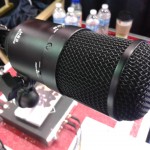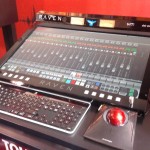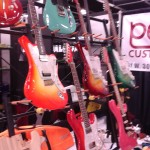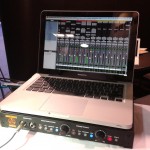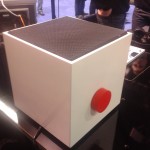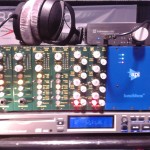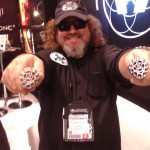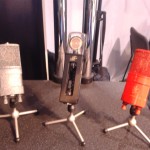NAMM 2013 Walking Tour: Notable Highlights from Anaheim
Hype this isn’t: The mood at the music industry’s megashow known as NAMM was truly upbeat in 2013.
Common consensus among veteran NAMM exhibitors was that traffic was up, and that an optimistic outlook had returned to the attendees after a noticeable pause. The creativity among people who play instruments and those who record them may never have left, but confidence did take a leave of absence.
So can mega-breatkthroughs in audio hardware and software be far behind? They may be in the offing, but you would have had to look extremely hard to find a full-out mind-blow. Instead, the oft-repeated mantra from manufacturers at NAMM 2013 was “evolutionary, not revolutionary”.
That said, there were some eye-opening advances to be found throughout the show, comprised of new products that are available now and others that will officially ship in the coming months.
Want to know what officially floated our boat? Following are the SonicScoop Picks for NAMM 2013 – sharp new hardware, innovative plugins, or items we just plain dug upon:
We took notice of the Telefunken M82 dynamic mic when it was first announced earlier this month, but it was even more enticing when experienced in real life at the NAMM booth. It’s flexibility as both a kick drum and vocal mic is an intriguing combination, and a number of controls on the M82 afford it even more versatility. Trying it on the kick drum was not an option at NAMM, but vocals through the mic sounded crisp, clear and extremely present.
Our visit to the Aviom booth found us face to face with company founder Carl Bader, who was genuinely psyched to walk us through the new Aviom A360. The unit represents the next generation of Aviom’s now-ubiquitous A-16II personal mixer, with loads of new control and customization tools. It has an advanced 36-channel mix engine which can be used to mix up to 17 mono or stereo channels plus mono or stereo ambience. It also has a number of features which really must be experienced first-hand – especially “Enhance,” and the “Spread” function within the Stereo Placement section – all of which are designed with improved in-ear monitor performance and comfort in mind. Once word gets out, expect to see the A360 in studios, live TV, theater, and more.

Shel performed with a quartet of DPA d:facto II Vocal microphones, each one transmitting via a wireless system from a different manufacturer.
We admit it — it took us a second to get our heads fully around the new d:facto II Vocal Microphone when DPA announced it in early January. Fortunately, the magic of NAMM brought us face-to-grille with these versatile mics, and then it instantly made sense: the modular capsule system is the key to allowing these mics to work seamlessly with a number of different wireless systems from different manufacturers (including Sony, Lectrosonics, Shure, Wisycom and Sennheiser). The newest generation of this vocal-centric DPA mic is also available with a new wired handle. On Friday, the Colorado four-sister act known as Shel made the DPA booth an entertaining place to be, drawing a crowd (listening via headphones) with their masterful mix of mandolin, violin, keyboards and vocals.
Waves, DiGiCo and Soundtracs announced their new co-developed DiGiGrid, which provides users of Native DAWs, Pro Tools and MADI-enabled live and broadcast mixing consoles access to Waves SoundGrid audio-over-ethernet networking and real-time processing. The system is available in several different versions featuring different I/O configurations – for example, DiGiGrid IOS was designed for personal production studios and consists of an 8 x 8 I/O and a built-in SoundGrid Server that provides a high-speed Ethernet connection to your DAW. This connection allows the engineer to insert Waves plug-ins into their chosen platform.
Meanwhile, Waves’new-at-NAMM software mixer, the eMotion Mixer, supports multiple mixers and DAWs, I/O boxes and SoundGrid DSP servers over a single network. Amid questions at and post-NAMM, Waves also confirmed that it will support the AAX Native plug-in platform. Pricing and availability TBA.
Slate Pro Audio was its usual center of attention, reeling ‘em in three deep all week with the giganto-sized Raven control surface/touch interface, which we first experienced at the 131st AES. This time, however, its more practical – and attainable – little brother, the Raven MTi Multitouch Desktop Production Console, providing DAW Control and Analog Monitoring, was along for the ride. Living within a 27” LED-backlit IPS HD LCD panel, it provides 24 simultaneous multitouch channels in the Raven DAW controller. In addition, it flies into your studio as an analog monitor controller, capable of connecting to four stereo analog and digital sources, with independent speaker, console headphones, and studio headphones outputs – plus a lot more. The estimated MSRP for this baby: $3,500, with an anticipated US ship date of summer 2013.
A couple rows away, Kemper Amps – the makers of the Kemper Profiler – were demoing their new Kemper Profiler PowerHead ($2,730) and PowerRack ($2,025) systems. For the uninitiated, the Kemper Profiler concept is a new approach to guitar sound – instead of modeling classic amps, this system captures the user’s own unique amps and stores these profiles for use in the digital domain. Then you can tweak as usual using the Profiling Amplifier’s tone and gain controls. The PowerRack features a very similar interface to the lunchbox version with a layout that will be familiar to users of traditional amps – gain, tonestack and volume are immediately accessible, and the front panel also has dedicated knobs for reverb and delay.
We also encountered for the first time the beautiful custom guitars of Peekamoose. They first caught our eye due to the NYC address, but the more we learned about their innovative manufacturing techniques, and the longer we talked to their inspired/inspiring creator Paul Schwartz, the more we liked them. Take a second to visit their home page and check out the fascinating behind-the-scenes video of this Manhattan guitar maker.
At PreSonus, we were impressed with our first listen of the Sceptre CoActual 2-way studio monitors. Leveraging custom transducers and TQ algorithms from Fulcrum Acoustics’ Dave Gunness, the Sceptre demonstration showed that it delivers terrific clarity and detail in the mixes, and appears to have power to spare. And while we didn’t get our hands on the newly announced 32-channel, 14-aux PreSonus StudioLive 32.4.2AI we can safely say – it sure looks bigger than the StudioLive mixers that have preceded it.
At the always-huge Avid village – we mean booth — there was plenty of interest in the new Pro Series of AAX plugins (Compressor, Limiter, and Expander). A just-announced song competition in conjunction with Abbey Road Studios provided a welcome link to the real musical world outside (details to come on SonicScoop).
The Dangerous booth proudly displayed The Source front and center, and with good reason: Their recently introduced USB monitor controller had scored a win in the 28th Annual TEC Awards, capturing top honors in the “Amplification Hardware/Studio & Sound Reinforcement” category. Congrats to Dangerous! (And all the other winners at the pro audio industry’s flagship awards event – see the complete list of winners here).
When we dropped in on the class act ribbon microphone specialists AEA, they hipped us to the launch of their new Webzine http://www.fixitinthemic.com. Beautifully shot video, interviews, and insights await those who click upon it!
Right next door was the Universal Audio booth, which had no shortage of buzz due to their just-released enhancements for the Apollo Audio interface. Demonstrated most ably by Fab of NYC’s FLUX Studios, the system showed its powerful prowess with is new capabilities as a scalable system with multi-unit cascading. The newly arrived API 500 Series plugin collection, and the freshly minted Teletronix LA-2A Classic Leveler plugin collectionwere also UA announcements worth noting.
As we drifted by the Teenage Engineering booth, what to our wondering eyes did appear but the tantalizing OD-11 – what they hail as the world’s first Cloud speaker. Built from the ground up especially for listening to music stored in the cloud, the OD-11 combines a 1974-originating design with Bluetooth and some truly beautiful control features, as elegant as they are advanced. Availability hasn’t quite yet arrived (a summer arrival is promised), so we highly encourage you to watch this space: http://www.od-11.com/.
Upstairs, Line 6 had a well-attended room, where the latest product announcement was the new L2m and L2t loudspeakers from their StageSource family. On prominent display was the Dream Rig, played with mucho gusto by session guitar ace Sean halley, as he demonstrated the extremely versatile combination of Line 6’s Variax89F, POD HD 500, and DT-series modeling amp.
It was great to come face-to-face once again with the JBL M2. An intensely innovative Master Reference Monitor, the M2 shows that JBL is serious when it comes to shaking up preconceived notions about music and audio post monitoring. Watch for this speaker to make waves when it becomes available this Spring.
The Aphex booth arrested us with two different items. First off was the USB 500 Rack, which cleverly combines a 500 series frame and a USB 2.0 audio interface into one product. The output of modules can be assigned to DAW tracks, can be run in series as on a channel strip, modules can be used as hardware inserts over USB, or the unit can also function as a standard analog rack – look for it to come online in May with a $799 price tag. Also now officially on radar is the soon-to-be available Microphone X ($299), a USB microphone which includes an Aphex optical compressor, plus the Aphex Aural Exciter and Big Bottom processors built right in. PHUN. Equally stimulating was talking to the Aphex engineers at the booth – their excitement for the company is palpable right now, as they sense the opportunity to re-ignite interest among engineers and musicians about the brand.
Speaking of 500 modules, engineers and producers were treated to an up-close look at some extremely high-fidelity units at the Transaudio Group booth. There, gear guru Geoff Daking was presiding over his latest creation, the Daking 500 REC system: two Mic Pre 500’s, two Comp 500’s, two EQ 500’s, in an API Lunchbox ($5100). Just as intriguing was the new Falcon, the $1250 500 Series compressor that represents the first tube design in decades from the legendary Dave Hill. Also on display, Drawmer 500-series D5101 gates ($399).
For a DAW to put at the center of all this, Cakewalk led us through a demo that made a strong case for Sonar X2 Producer. The latest edition Cakewalk’s fast-evolving recording/mixing/mastering workstation displayed an extremely sophisticated approach to workflow and ergonomics – a lot of the things you’ve wished for to speed up mixing are definitely here, in features like the ProChannel and CPU-friendly Console Emulator.
Later on, the DJ within us was tingling all over when we reached the Pioneer booth. We may not be able to spin circles around Junior Sanchez (yet), but we could feel the magic in Pioneer’s RMX-1000 Remix Station. Not only terrific for performing DJs, the RMX-1000 is clearly a terrific realtime tool for in-studio remixers and EDM producers in search of a fast path to changing up sounds. Like serious fun? Get your hands on one.
Character was in no short supply at the Holophone booth, as we received a personal audience with the memorable company founder Michael J. Godfrey aka “SuperMike”. SuperMike showed us Holophone’s new single channel microphones (a departure from its famed surround miking systems), starting with a double-fisted helping of the weighty and highly customizable Super C supercardioid stage/studio mics. The freaky “Classic” – a single-channel version of the iconic Holophone head was there for the auditioning as well.
The beauty of a trade show like NAMM isn’t just catching up with the big names, but also finding the emerging upstarts as well. Case in point would be Zynaptiq, creator of the impressive UNVEIL de-reverberation and signal focusing VST/RTAS/AAX/AU plugin (Mac/PC). According to Zynaptiq, UNVEIL “allows attenuating or boosting reverb components within a mixed signal of any channel count, including mono sources, as well as modifying reverb characteristics. Additionally, UNVEIL allows you to bring the key features of a recording into focus, or move them to the background, by attenuating or boosting perceptionally less important signal components.” We just thought it sounded extremely useful. Zynaptiq’s CEO also convinced us in an instant how PITCHMAP, “the world’s first and only plug-in that allows processing the pitch of individual sounds within mixed signals in real-time,” just might be a time-starved composer, producer or remixer’s best friend.
Just a few feet away, we got our first look at the Micco Pro-Studio, a wall-mounted microphone stand with height-adjustable reflection screen – perfect for smaller studios (MSRP: $399).
Latvian mic manufacturer JZ Microphones was on the floor, celebrating its 5th Anniversary with a new online custom shop for studio microphones: Over 500 combinations of their highly-regard Vintage 11 (V11) cardiod mic can be whipped up in minutes.
Last, but certainly not least, we see another upstart in Sonarworks, a new, very well-thought-out speaker calibration software program that’s simple to use and extremely powerful at the same time — with some unexpectedly useful, additional applications. The enthusiasm of the company’s Partner, Helmuts Bems, reinforced the optimism and spirit of adventure that shone through so much of this year’s NAMM show.
Let’s all meet up next year, same time, in Anaheim! Until then, looks like there’s a lot of music to make.
— Janice Brown & David Weiss
Please note: When you buy products through links on this page, we may earn an affiliate commission.







